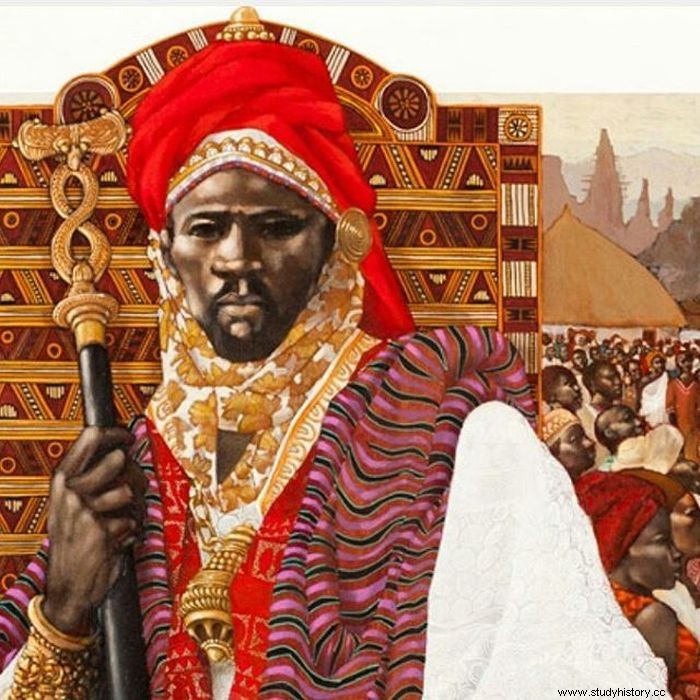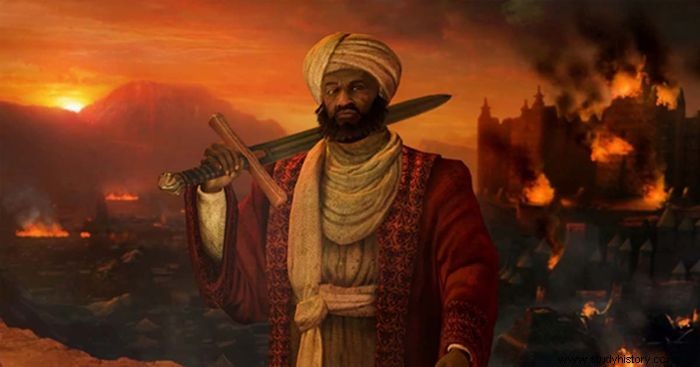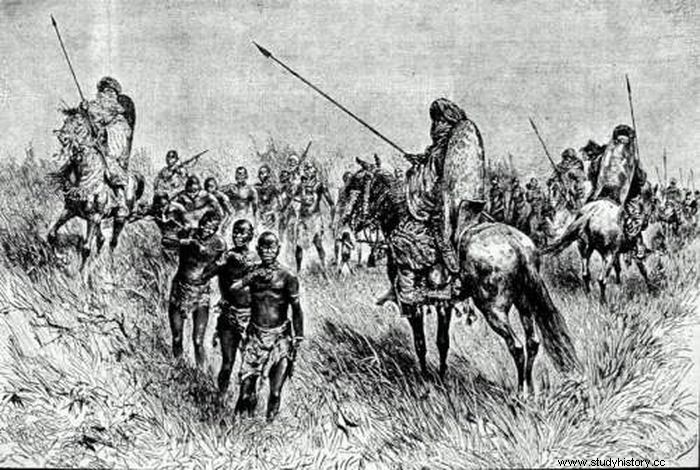In the 9th century AD. the people of the city of Gao along the Niger River spread into the Central Niger area, becoming the Songhai state in the West African savannah. The Songhai Empire prospered due to river trade focused on agricultural products, fishing, hunting and ironworking technologies. Songhai's influence and wealth increased due to his involvement in trade across the Sahara. Trade in gold, salt, ivory, leather, copper and other objects took place between North African Berber traders and West African forest producers.
Songhai was one of the largest African empires, spanning from the early fifteenth to the end of the sixteenth century. Songhai was the largest kingdom in African history, controlling thousands of tribes.
The Rise of the Songhai Empire
The Mali Empire, based in Timbuktu, had controlled the region around the Big Bend of the Niger River before establishing the Songhai Empire. The mighty Mali Empire noticed Songhai's success and annexed the empire in the 14th century. The Songhai Empire amassed enormous wealth through trade and tribute it received along the Trans-Saharan trade route.
As Mali crumbled, Songhai's independence was restored. The establishment of the Songhai Empire took place when the Songhai people of Gao broke out of the Mali Empire. The capital of the Songhai Empire was established in Gao, a walled city that served as a central trading center. The Sonni dynasty began to expand its borders in the 15th century. In 1473, Sonni Ali had led Songhai's cavalry and canoe fleets to victory over the Tuareg and Mossi armies. The conquest of the rich cities of Timbuktu and Jenne also took place under their rule.
Sonni Ali Ber and his successor, Askia Muhammad Toure from 1492 to 1528, made the Songhai Empire the most powerful in West Africa. It was larger than both Mali and Ghana. In addition, it was the first country in the region to establish an organized system of government. Sonni Ali used the cavalry and a mobile fleet of ships to forcibly transform Gao into the Kingdom of Songhai.
Sonni Ali was succeeded by Askia Muhammad Toure, who created Askia as a new government dynasty. He continued Sonni Ali's expansionist strategy by conquering a key oasis in the Sahara desert and eventually defeating Mali. Askia Muhammad Toure then captured other adjacent kingdoms in subsequent expeditions. Eventually, he consolidated his authority by establishing a massive bureaucratic corps to monitor and administer his empire.
Muhammad Toure was a visionary who revolutionized trade by standardizing weights, goals and money, and merging the many Songhai civilizations into a single national culture.
Kong Sonni Ali Ber

Around 1468, King Sunni Ali, also known as Sonni Ali Ber, switched from Songhai's regular periodic attacks on opponents to a more sustained campaign of permanent territorial expansion. Sunni Ali conquered the former Mali Empire with an army equipped with armored cavalry and the only navy in North Africa, by placing it on the Niger River.
The Songhai ruler used his image as an indigenous religious wizard to intimidate his enemies. He also managed to combine mercy with harshness. As a result, the monarch received the moniker "Sunni the Merciless". However, Sunni Ali's tactics of overwhelming with overwhelming force and speed were even more effective than these measures. After the conquest of land by the monarch, they were divided into provinces and governed by a governor. Sunni Ali extorted tributes from local leaders, took hostages and arranged political alliance marriages. But he also built many dikes that improved irrigation and agricultural productivity in many places.
Kong Askia Mohammad Toure

King Mohammad I (1494-1528 AD), a former Songhai army captain who had plundered the kingdom from Sunni Ali's son, Sonni Baro, began using the dynastic title Askiya or Askia, meaning "ruler" or "usurper". -ruler". The new monarch wanted to command the largest territorial extent of the Songhai Empire for the first time. He consolidated his position as the second most powerful leader of the Songhai Empire after Sunni ali.
One of the motivations for King Mohammad The purpose of expanding the interests of the Songhai Empire to the southeast was the loss of control of part of West Africa's gold trade to the Portuguese. Gobir, Katsina and Zaria, three key towns in Hausaland located between the Niger River and Lake Chad, were attacked. Kano, the region's fourth largest city, was forced to pay a big tribute to the Songhai ruler.
During this time, the capital of Gao had a population of 100,000 XNUMX people. The empire practically ranges from the Senegal River in the west to central Mali in the east. In addition, the valuable salt mines at Tagahaza in the north were part of the area. As a result, the Songhai Empire ruled the entire length of the Niger River, practically West Africa's commercial highway. The Songhai people became a small minority in a policy that included Mande, Fulbe, Mossi and Tuareg.
Trade under the Songhai Empire Rule
By 1469, Songhai had taken control of Timbuktu on the Niger River, which served as an important trading port. The Mossi areas south of the Niger bend were attacked in 1471. Djenne, the region's second major commercial center, was captured in 1473. However, Sunni Ali's new territory did not allow him access to the goldfields on the south coast of West Africa. It was here that both the monarchs of Ghana and Mali became prosperous. This trade took place because in 1471 a Portuguese ship commanded by the Lisbon merchant Feno Gomes sailed across the Atlantic coast of Africa. There he established a trading foothold near these golden fields in present-day Ghana.
With the arrival of the Mediterranean route, camel caravans across the Sahara face stiff competition. This is because it is the best way to transport commercial products between North Africa and Europe. However, the Portuguese were not as successful in exploiting the riches of Africa as they had intended. Songhai monopolized the Saharan caravan trade. They supply rock salt and luxury goods such as fine fabric, glass, sugar and horses to Sudan in return for gold, ivory, spices, cola nuts, leather and slaves. Timbuktu thrived as a "trading port" and a study center into the 16th and 17th centuries. The city had a population of over 100,000 15 in the mid-XNUMX century.
Shopping centers are evolving into sophisticated city centers with stone-built homes, large public squares with marketplaces and at least one mosque. A floating suburban population lived in clay and reed houses or tents around this center. Meanwhile, rural communities remain completely dependent on agriculture, although the spread of rural markets typically involves a food surplus. Famine was undoubtedly uncommon in the early half of the Songhai Empire, and there are no reports of peasant uprisings.
Islam emerged under the Songhai Empire
A monarch named Za Kusay was the first documented Songhai who converted to Islam in 1010 AD. On the other hand, the ruling elite continued to embrace animistic beliefs such as numerous gods, possessions, dances, and sorcery.
After the death of the Sunni Muslim Ali Ber, Askia Muhammad took over the kingdom. However, Islam did not fully spread among the non-ruling elite. Sunni Ali claimed to be a Muslim, but oral history shows that he had conventional animistic views. On the other hand, Askia Muhammad was a devout follower of Islam.
Askia Muhammad immediately appointed Islamic judges and led the construction of hundreds of Islamic schools throughout the empire. He built, in particular, Sankore, West Africa's first known Muslim university, in Timbuktu. Those who seek religious enlightenment and those who seek a decent education come to these institutions. Here they took up Islam and spread the message.
Askia Muhammad, a skilled diplomat, set out on his famous voyage to Mecca in 1495 with a large entourage and about 30,000 XNUMX gold coins. He distributed to charities and gave a lavish gift to everyone he met. With this action, he established diplomatic relations between Gao and Mecca and was given the name "Caliph of West Sudan", giving him extraordinary power among West African Muslim kings.
When Islam had taken root in his rule, Askia Muhammad sent missionaries to neighboring countries to preach the faith. As a result of the king's jihad, the Fulani, Tuareg, Mossi and Hausa tribes are Muslims, although he never forced them or anyone else in his kingdom to convert. Instead, the king rewarded them only by establishing Muslims as the elite and providing a springboard for the poor and ignorant to join them. In other words, he made Islam a more attractive social and economic alternative than animism.
Songhai Empire Governance
Compared to the more federal structures of the previous Ghanaian and Mali empires, the Songhai administration was far more centralized. Despite having around 700 eunuchs at their court in Gao, the Songhai monarchs were never completely secure on their thrones. Six of the nine rulers of the Songhai Empire accidentally died in revolt or were killed violently, mostly by their brothers and uncles.
It was an imperial council of high officials, which included the finance minister, the admiral of the Songhai fleet, who also oversaw the provincial governors, the army chief and the agriculture minister if a monarch ruled long enough to make money from it. Forests, wages, purchases, property and foreigners were monitored by ministers. A chancellor-secretary handled the formal documentation. In addition, many authorities with specialized responsibilities, such as police or inspection of the use of official guards at commercial centers and leaders of local craft guilds and tribal groups, were present at the local level. The local tax collector, who collected goods for the crown to pay the army, and court and give some support to the needy, was an official who no one could avoid, even if the wealthy had to pay him more than the poor.
Songhai Empire Army

Sonni Ali restructured the army, equipped with a flotilla from the Niger River. The fleet commander was given the title 'Master of the Water'. Infantrymen happen to seize the best men in the fallen army. The army also had a fast and strong elite cavalry. During their combat tunics, they wore iron chest plates.
The infantry used spears, arrows and leather or copper shields. A group of trumpeters composed military music, and the total strength of the army was 30,000 soldiers and 10,000 XNUMX cavalry. The Songhai defense system was the largest organization in force in western Sudan. It happened to serve as both a political and economic weapon, thanks to the stolen goods it brought in. They took over Timbuktu and Jenne.
Slave trade from the Songhai Empire
The slave trade was crucial to West Africa's economic prosperity. The use of slaves to perform hard labor took place for a long time in West African countries. The deployment of slaves as troops took place in the Songhai dynasty under Askia Mohammad. Expectations for slaves were to obey their masters. Even the appointment of slaves took place with positions of power as royal advisers. Unlike other people who had a personal stake in the outcome of decisions, slaves were trusted by the Songhai monarchs to give an objective opinion. Palace slaves, sometimes known as Arbi, were another type of slave. Slaves from Arbi mostly worked as craftsmen, potters, woodworkers and musicians. Slaves also worked on village farms to help produce enough food to feed the growing urban population.
The fall of the Songhai Empire
From the last quarter of the 16th century, the Songhai Empire began to erode along the edges, especially in the west. This decline was primarily due to a series of ineffective leaders and civil rights struggles that had plagued the empire since King Mohammed's death in 1528. First, the empire was virtually split in two by a battle between Mohammad IV Bano (1586 AD) and his brothers. Then came the fatal death blow. In 1590-1, the Moroccan chief Ahmad al-Mansur al-Dhahabi (1603 AD), called the "Golden Conqueror", sent a small force of 4,000 men equipped with musketeers to attack the empire. The Songhai force had 30,000 10,000 soldiers and XNUMX XNUMX cavalry, but all they had were spears and arrows.
The Moroccans won the battle because of this technological disadvantage, despite periodic but ineffective Songhai counter-offensives over the next few years. Eventually, the conquest of the Songhai tax took place, and the empire was merged with the Moroccans, and Timbuktu became a province in it. The Songhai Empire, once the largest in West Africa, had disintegrated and disappeared from within. Since the sixth century, it would be the last great empire to rule West Africa.
The Portuguese entry in search of new economic opportunities in the 15th century changed the trade network in West Africa. The change in the course of the slave trade across the Atlantic, rather than via the Sahara Desert, was a significant change. As a result, small West African kingdoms such as Asante and Dahomey gained more strength. Because the slave and gold trade no longer passed through the Songhai Empire, it also contributed to the demise of the Songhai Empire. As a result, the Songhai kings could not collect taxes or taxes from these nations.
The conclusion
Many events contributed to Songhai's decline, especially the tragic loss of Songhai's most important commercial cities. Songhai was effectively decimated due to this significant reduction in trade and revenue sources. The Moroccans never completely attacked, but Songhai was injured and eventually collapsed. The ultimate battle of the Songhai Empire did not come through Moroccan conquest, but from the inability of the smaller kingdoms to build a political union and a powerful central authority. Many tributaries in Songhai that had previously been suppliers of slaves to trade routes across the Sahara were liberated due to the Moroccan invasion. Many subordinate slave populations rose to give the ultimate blow to the crumbling empire, and saw their chance to guarantee bodily independence.
